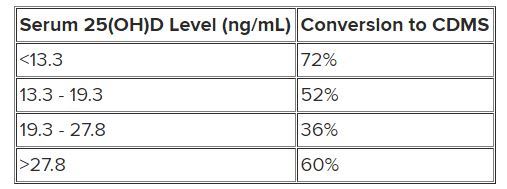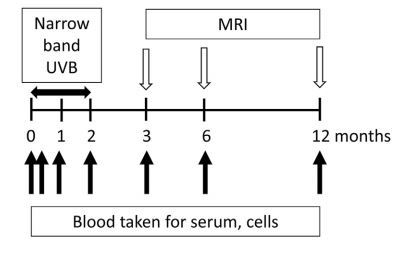Clinically Isolated Syndrome progresses to Multiple Sclerosis, unless UVB treatments – RCT
Ultraviolet light offers MS relief
“The trial, funded by MSWA, was carried out in 20 people with a clinically isolated syndrome — the first signs of a disease that could be MS but had yet to progress. All had sufficient levels of vitamin D.”
“In the half of people given narrowband UVB treatment three times a week for eight weeks, only 30 per cent progressed to MS.” vs 100% progressed without UVB

Previously published description of the trial
Narrowband UVB Phototherapy for Clinically Isolated Syndrome: A Trial to Deliver the Benefits of Vitamin D and Other UVB-Induced Molecules.
Front Immunol. 2017 Jan 24;8:3. doi: 10.3389/fimmu.2017.00003. eCollection 2017.
Hart PH 1 prue.hart@telethonkids.org.au, Lucas RM2, Booth DR3, Carroll WM4, Nolan D5, Cole JM6, Jones AP1, Kermode AG7.
Low vitamin D and insufficient sun exposure are additive independent risk factors for the development of multiple sclerosis (MS). The usual measure of vitamin D status, serum 25-hydroxy vitamin D [25(OH)D], is also a marker of recent exposure to the UVB rays of sunshine. The main evidence for a protective effect for MS development of higher 25(OH)D comes from observational studies, but this study design cannot separate out whether 25(OH)D is acting as a marker of vitamin D status, sun exposure, or both. In light of a lack of definitive outcomes in MS patients after trials of vitamin D supplementation and the ability of narrowband UVB to induce vitamin D, as well as other immune-regulatory molecules in skin, the Phototherapy for Clinically Isolated Syndrome (PhoCIS) trial was established to investigate the benefits of narrowband UVB, in addition to supplemented vitamin D, on MS development in individuals with Clinically Isolated Syndrome. We propose that the PhoCIS trial provides a fresh approach to re-defining the reported associations of 25(OH)D levels with MS development and progression.

PMID: 28167940 📄 Download the PDF from VitaminDWiki
